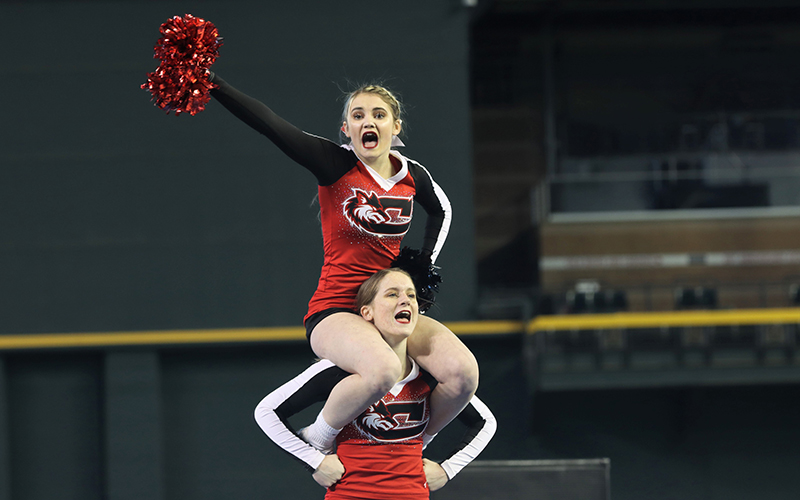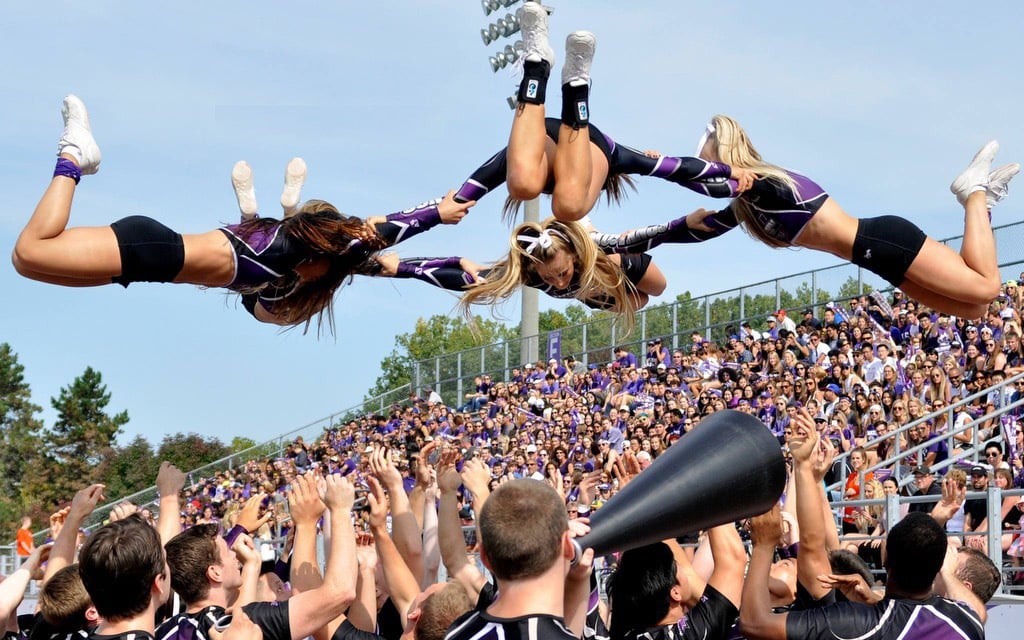
More and more cheer teams are coed, just like the University of Western Ontario’s cheer team. Despite the athleticism involved, cheerleading is still struggling to be accepted as a sport. (Photo courtesy of David-Lee Tracey).
PHOENIX – “We’ve got spirit, yes we do!”
We also have a lack of recognition, a lack of regulation, stereotyping, discrepancies in funding and psychological impacts, many cheerleaders will tell you.
Behind the glitz, glamor and stereotypes, a large number – over 3 million in the United States alone – of women and men are dedicated to cheerleading. For the typical two-and-a-half-minute routine, the average cheerleader often spends eight or more hours a week in the gym undergoing intense training for tumbling and pyramid work.
Yet a lack of respect for cheer endures.
“The amount of people that have said to me cheer isn’t a sport when athletes are putting in hours and hours of work at the gym, it’s just heart-wrenching,” said former cheerleader Taylor Mohr, who is based in Arizona. “I think to myself, ‘How can I put so much effort towards something and then just by a phrase, people completely downplay me?’”
Both governing bodies for cheer, and cheerleaders themselves, have lobbied to be recognized for years, yet it continues to be denied acceptance as an official sport, both by the NCAA and the U.S. government.
Title IX, a law designed to prevent gender-based discrimination in schools in the United States, has had a tremendous impact on what opportunities are available to female athletes. The NCAA and Title IX are intertwined with one another, meaning that a sport can only benefit if it is officially considered by both.
Almost 50 years ago, in 1975, cheerleading was deemed an extracurricular activity by the Department of Education’s Office of Civil Rights, meaning cheer could not be used to satisfy Title IX requirements. The problem, though, is that this holding did not consider cheerleading in its modern form, which emerged in the 1980s.
Currently, there are several disciplines within the world of cheer. Scholastic cheerleading includes both collegiate and high school. Outside the school setting, there is club cheer, in which individuals can participate either recreationally or competitively – commonly known as “All-Star Cheer.” Additionally, a newer discipline exists, separate from the crowd-leading elements, called “STUNT,” which is offered both in and outside of schools.
“There was so much confusion around whether or not cheer was a sport, and school districts would try to claim Title IX with cheerleading, and it would be denied,” USA Cheer executive director Lauri Harris said. “We created STUNT to check all the boxes of being a sport. We’ve taken the skills from cheerleading, and we put it into a head-to-head game format.”
Because of the sheer variety in forms of cheerleading disciplines, including the fact that it can be either all-female or co-ed, it has struggled to move past preconceived notions associated with the sport, which has played into the battle to move beyond the 1970s Title IX status.
As recently as 2010, a federal judge ruled that cheerleading still did not qualify as a varsity sport under Title IX, following the 2009 lawsuit filed against Quinnipiac University on behalf of the women’s volleyball team. This was sparked due to Quinnipiac elevating cheerleading to varsity status, while simultaneously cutting volleyball.
Even at the international level, cheerleaders appear to be fighting a losing battle. Cheerleading was officially recognized as a sport by the International Olympic Committee and the United States Olympics and Paralympics Committees in 2021 and 2023, respectively. Yet it was not one of the four new sports added for the upcoming 2024 Paris Olympics.
“A long time ago, we thought it was supposed to be included in the Paris Olympics,” said Cooper Skiba, a cheerleader for Cheer Canada’s Senior National Team and Western Kentucky University. “I was even supposed to be competing, which would have been really exciting. But they didn’t end up adding it in.”
Nor did cheer make the shortlist presented by the Los Angeles 2028 Olympics committee.
Lack of recognition means lack of regulation
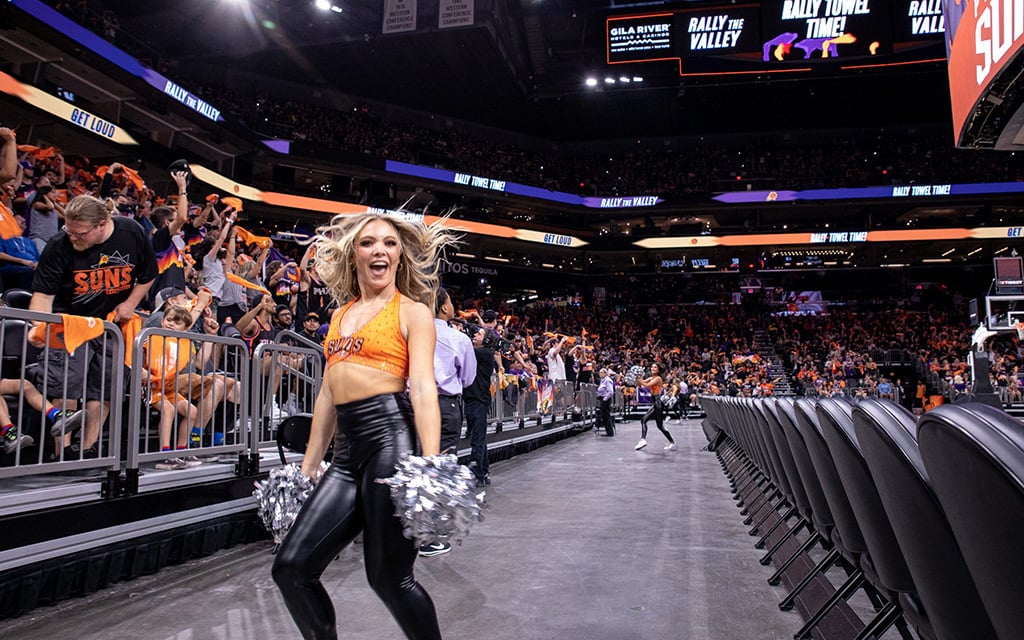
Respect for cheerleading can fall short at every level. Here, a cheerleader dances in front of Suns supporters during a short break in action. (File photo by Alberto Mariani/Cronkite News)
Because many external governing bodies do not consider cheer to be a sport, including the NCAA, cheerleading does not have the same level of regulation as so-called “sanctioned “sports. Yet with routines that include stunts such as a basket toss, which involves throwing a cheerleader 20 feet in the air, cheer is in fact the most dangerous form of physical activity for females in terms of concussions and “catastrophic” injuries – injuries that can result in permanent disabilities or shortened lifespans.
“Cheerleading is probably one of my top five sports that I treat for catastrophic injuries,” sports physical therapist Doug Stacey said. “If you look at sheer numbers, the numbers aren’t that far off between football and cheerleading.”
To further put this into perspective, the National Center for Catastrophic Sport Injury Research, which studied scholastic sports from 1982 to 2018, reported that despite cheerleading reporting fewer injuries today than in the 1980s, cheer still ranked higher in terms of rates of injury over time than 23 of the 24 NCAA-sanctioned sports.
Several lawsuits have been filed regarding safeguarding within the realm of cheerleading, due to a lack of access to adequate medical care.
“The fact that they’re not a varsity sport means their access to higher-level therapists who are busy with football or rugby, for example, isn’t great,” Stacey said. “The biggest catastrophic injuries that I saw in cheerleading were ankle injuries, concussions and knee injuries. It is a very high-risk sport. They need a medical management team to keep an eye on every aspect of what’s going on.”
Often, because of inequitable access to medical professionals or athletic trainers, coaches have to take on the task of rehabilitating injured cheerleaders, on top of the responsibilities they already hold.
“I mean, I am the team trainer, the driver of the team vans, I do it all,” said David-Lee Tracey, cheerleading coach at The University of Western Ontario. “I would sure love to not be taping ankles or doing concussion evaluations at the beginning of practice when I should be doing something else. I would love to have a proper training staff in there, as would just about every cheer coach in the world.”
Cheerleaders, too, believe that stronger regulations surrounding medical care, both in scholastic and non-scholastic settings, could further reduce the frequency and severity of cheerleading injuries, especially considering the level of athleticism and training required to perform most cheerleading stunts.
“I don’t think a lot of people realize the physical toll it has on your body,” Mohr said. “You’re throwing girls in the air or you’re flipping yourself in the air. It’s this incredible talent that’s happening. That can have repercussions.”
Meg Watkins, a base cheerleader, tore her ACL, LCL and meniscus after her flier fell on top of her while rehearsing a new stunt.
“It’s hard to stay in the sport, honestly. My injury, and the severity of it, is 100% an argument of why cheer should be a sport,” Watkins said. “When you’re just out of surgery, missing school for doctors appointments every two days, and you’re trying to work your hardest to come back into the gym, it almost feels like what you’re doing doesn’t have a purpose. It’s really frustrating. Just because I’m a cheerleader, doesn’t mean I’m not strong.”
More than just the sideline
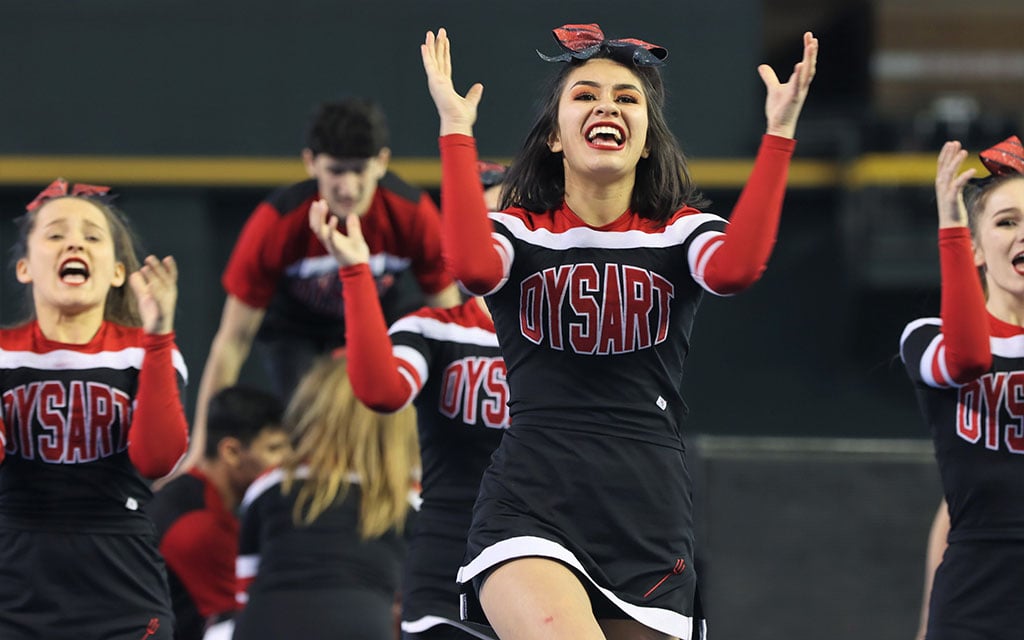
Cheerleaders, including those at Dysart High School, have to worry about injuries. Studies show that cheerleading is among the leading causers of concussions and catastrophic injuries for girls. (File photo by Reno Del Toro/Cronkite News)
Due to its history and association with bolstering school spirit, as well as media perceptions in movies like 2000’s “Bring it On,” cheerleading has had trouble separating its two purposes.
“You’ve got competitive cheer, and then you have sideline cheerleading. Those are two very different things,” Title IX expert and sports media professor Ellen Staurowsky said. “Cheerleaders suffer from a societal view of being arm candy for male athletes. The NCAA built its narrative on cheer when it was an all-men’s institution.”
However, many All-Star programs and STUNT programs do not incorporate any sideline elements. Instead, they focus on athleticism and competition. This inherent tension between the different models of cheerleading poses concerns for stereotyping.
“I think one of the reasons people don’t think of cheerleading as a sport is because a college cheerleading squad is made up of two very, very separate things,” said Kate Torgovnick May, author of “Cheer: Inside the Secret World Of College Cheerleaders.” “They’re at collegiate events supporting other teams, and that’s the social public persona.
“For women in cheerleading, there’s the stereotype that she’s a white female, who’s upper middle class. But I’ve met cheerleaders of every gender expression, from every place in the spectrum you can imagine. For a lot of them, they were really thankful that they found this thing that let them be athletic.”
Stereotyping can particularly affect male cheerleaders. Despite making up 50 percent of collegiate cheering squads, public perceptions of cheer can often discriminate against or diminish the efforts of male cheerleaders.
Take Skiba, for example. He left playing hockey for cheerleading at age 10 for many reasons, but not without backlash from some of his peers.
“There were always comments, and it was mostly just people making fun of me for being in a sport with a lot of girls, or comments about the stereotype of being homosexual,” Skiba said. “I just had to come to terms with the fact that this was my passion, and I was going to do what I wanted to do. There are a lot of things in the world that aren’t traditionally masculine that guys still do.”
An added layer to this is the experience of Black male cheerleaders. Jaleyl Edwards-Sharp, a Black male cheerleader at Prairie View A&M University, switched from football to cheer at the age of 5 with full support from his mother. However, Sharp stresses that the fact he had family support is an anomaly.
“Young Black boys specifically are inclined to bodily-kinesthetic intelligence,” Edwards-Sharp said. “We’re doing back walkovers at the age of six, self-taught, because it feels natural to us. But a lot of Black parents don’t put their children into cheer because of the idea that it’s a ‘pansy sport,’ or that it’ll increase their ‘likelihood of being homosexual.’ There still is a lot of work to be done around removing the stigma around cheer for Black boys specifically.”
The dark side of pom-poms
Another stereotype that cheer is faced with, which is perhaps more female-focused, is the sexualization of cheerleaders. The American Psychological Association Task Force defines sexualization as “when a person’s value comes only from their sexual appeal or behavior, to the exclusion of other characteristics, and when a person is sexually objectified.”
In 1974, the founder of the United Cheerleaders Association, Jeff Webb, sparked the modernization of cheerleading uniforms, similar in fashion to its contemporary format: body-fitting and made from moveable spandex material. With the change in clothing also came a larger emphasis on beauty elements such as show makeup and cheer bows.
Brooklyn Dronyk-McCullough, a former All-Star cheerleader and cheer coach, says she faced a large amount of sexualization during her time in the cheerleading world.
“In TV shows and movies, cheerleaders are dressed in a sexualized way and shown doing these provocative dance moves,” Dronyk-McCullough said. “When I started, there was such a stigma that cheerleaders are mean, catty and doing it just for attention. I was super sexualized by males and made fun of by other girls. They just think cheer is a sexual activity because women can’t do athletic sports.”
The sexualized stereotype, and subsequent lack of education, is widespread. In 2021, cheerleader Hayden Richardson sued Northwestern University, alleging that she and her fellow cheerleaders were presented as sex objects to garner more donations for the institution at fundraising events.
Although professional sideline cheerleading and dance teams for leagues such as the NFL or NBA are separate from competitive cheerleading, the problems that stem from sexualization affect individuals in all spaces associated with cheer. In 2018, five former NFL sideline cheerleaders sued the Houston Texans for paying them less than $7.25 per hour, all while subjecting them to harassment and objectification, they said.
This raises yet more issues that the cheerleading community is left to face: a lack of funding, and unequal treatment when it comes to pay.
Financial barriers surrounding cheerleading
A lack of NCAA-sanctioning means that collegiate cheerleaders do not have access to the same level of scholarship money as their counterparts. Even at Navarro College, the 16-time National Cheerleading championed program popularized in Netflix’s “Cheer,” cheerleaders only have access to a maximum of $1,000 a semester in scholarship money. Contrast that with collegiate sports at the highest level, Division I, where football and basketball scholarships are around $40,000 each.
“It is a very, very expensive sport, across the board,” Watkins said. “I’ve seen so many kids come through our program and not be able to afford it. I think it’s just because cheerleading has become so expensive, I mean you have to pay for fees, uniforms, choreography, hair, the bows, and traveling across the country for a competition. It all adds up. There are so many kids who have had to quit and give up on their dreams.”
“Because it’s considered more of an activity than a sport, you have to fund everything yourself,” Dronyk-McCullough added. “Even the biggest colleges and clubs have to hold fundraisers, but it’s really hard to balance school, cheer practice and these fundraising activities on top of it. Scholarship money only covers your fees. It’s very limited in terms of who can afford to cheer.”
Cheer programs and gyms often try their best to make it affordable for individuals wanting to participate, but sometimes it simply is not enough.
“I try to have different levels (of costs),” said Jennifer Lannon, owner of AZ All-Stars Cheer Gym in Tempe. “Recreational cheerleading can be a little bit cheaper, but it can still go up to thousands. People don’t see that (cheerleaders) have to do stuff like clean floors to try and offset some of the costs.”
A further complication is that there are only two national championship competitions for cheerleaders to participate in, either the NCA or the UCA. Both competitions are operated by the same privately owned company, Varsity Brands.
This means that competing for the title of national champion can cost thousands of dollars for a team, particularly when taking into account transportation and accommodations.
“It really is tragic that the NCAA does not recognize us. I mean we’d be happy to be given the same scholarships as other programs at our school,” Skiba said. “We have to do all this fundraising ourselves, while teams like the football and basketball teams kind of get everything handed to them.”
They see this as a deep irony to this discrepancy in funding: They don’t have equal access to funding as other sports, yet they are expected to cheer on the sidelines for these same teams.
Pay discrepancies for cheer coaches exist as well, especially when compared to other athletics. To put this into perspective, Power Five schools are reported to pay their head football coaches an average of $6.2 million, whereas college cheer coaches make an average of $19.70 an hour.
Tracey, who has been coaching Western’s cheer team for over 40 years, has led them to 33 national championships. Despite this, however, he is not paid a salary.
“Every single other athletic coach at Western is going to be getting a real salary,” Tracey said. “The norm for cheer coaches here (in Canada) is either $0 or an honorarium. They offered me $3,000 for the whole year. You would think that with my resume and my longevity here, I would probably be worth a few dollars, but I’m lucky if I get a free parking pass for game day.”
Tracey adds that he had to build and fund his training facility for his team, because of a lack of monetary support or practice space provided by the school.
“I’ve been having this conversation for about 35 years or more,” Tracey said. “You would never say to the basketball team, ‘Sorry guys, no practice this week, because there’s no gym for you.’ Cheerleaders are sequestered away in some auxiliary gymnasium or they get just a mat rolled out on a basketball court, even though they need a sprung floor.”
Historically Black Colleges and Universities’ cheer squads have it even harder. Research has found that HBCUs do not spend as much as their predominantly white institutions counterparts when it comes to athletic aid or head coach salaries, due to limited budgets and a lack of structural support.
“I would describe it as entropy,” Edwards-Sharp said. “I think a lot of the disorganization at HBCUs comes from a lack of funding. The program’s funding determines the coach’s competency, which is very disappointing because we must put more effort into someone who has such a big impact on young Black girls and boys. We went to the athletic department, but the communication can only go so far with them.”
The veil of superficial smiles
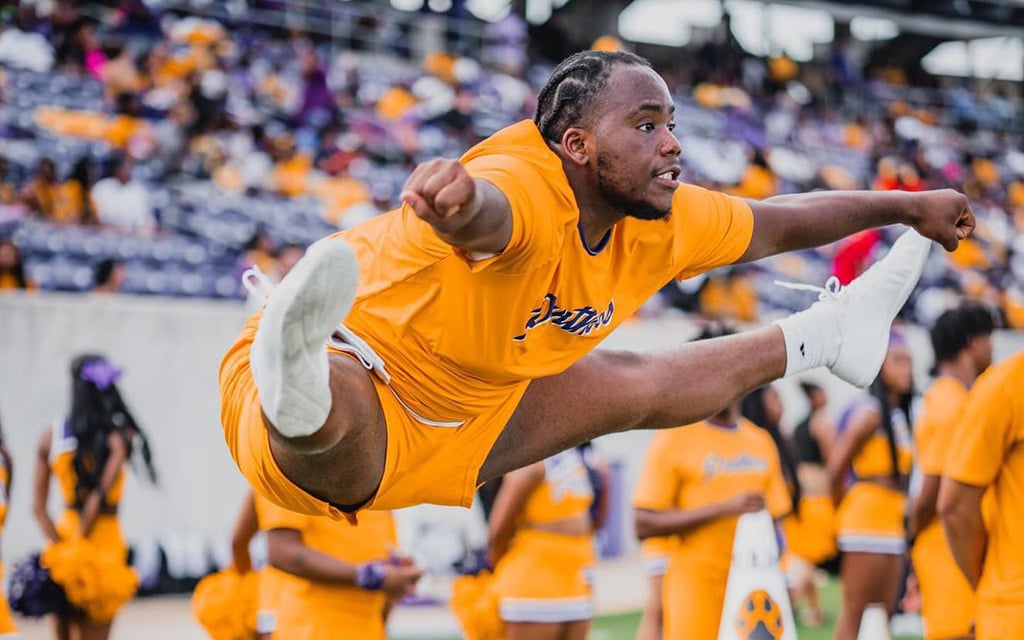
Jaleyl Edwards-Sharp, a cheerleader at Prairie View A&M University, switched from football to cheer at the age of 5. He is grateful for his parents’ support but knows it’s not all the way. (photo courtesy of Jaleyl Edwards-Sharp)
With a lack of recognition creating myriad problems within cheer, many individuals face psychological impacts and mental health issues, including, but not limited to, eating disorders, anxiety, depression and a lack of self-worth.
“I developed a really bad eating disorder, starting when I was 13 because I had to look a certain way,” Dronyk-McCullough said. “Some coaches tell you that you need to lose weight, and all the older girls had an idea of how their bodies were supposed to look to fit into tight uniforms. No one goes against it, and I got so fixated on my body. I don’t think I loved myself at that moment. I always wished there were more counseling programs for cheerleaders because my self-confidence was just so low.”
To put the prevalence of eating disorders into perspective, a 2022 study by the National Library of Medicine found that 34.4 percent of cheerleaders (all-girl, coed collegiate and All-Star) are at risk for an eating disorder.
“We tend to see that disordered eating behaviors in cheerleaders are among the highest,” said Dr. Ashley Coker-Cranney, who specializes in sport and exercise psychology and is also a former cheerleading coach. “A sense of control is one of those things that individuals who develop eating disorders are searching for. Cheerleaders don’t have a lot of control over their time. The athlete part needs to train for competition, the ambassador part needs to be available for appearances and some have to get part-time jobs, all while going to school full-time. It’s a very real concern to develop eating disorders in cheerleading.”
Adding to this is the presence of anxiety and depression, much of which stems from a sense of maladaptive perfectionism that is common in the culture of cheerleading.
Because it is not an NCAA-sanctioned sport, cheer doesn’t have the same level of access to psychologists. Because of this, there is significantly less information, and fewer solutions, for the unique mental health issues cheerleaders face.
“Mental health issues among cheerleaders tend to be pervasive,” Coker-Cranney said. “The issues that develop in one or two isolated areas end up affecting everything, and that can very quickly turn into PTSD. The NCAA has a survey twice a year where they look at the mental health of athletes. Yet cheerleaders aren’t represented within that sample. So we’re not hearing their voices.”
The flipside: cheerleaders keep cheering on

Desert Mountain cheerleaders stand during the national anthem before a football game. Even the cheerleaders’ short routines requires hours and hours of practice. (File photo by Brittany Bowyer/Cronkite News)
Despite their lack of institutional recognition, and even though they feel second-class in the world of collegiate athletics, many individuals involved in cheerleading still see a bright future ahead – one in which cheer would be validated as a sport.
Although the Los Angeles 2028 Olympics declined to short-list cheerleading for now, many think that the 2021 IOC recognition was a big step in the right direction.
“It was a huge accomplishment to kind of get that stamp of approval,” Harris said. “It opened up a ton of doors, really for growth in the international space.”
Many cheerleaders and their coaches, however, believe that for cheer to be successful in the Olympics, there still needs to be more standardization and organization within the sport. Although the NAIA (the governing body for small college athletic programs) recognized competitive cheer as a sport in 2016, some believe that achieving the goal of NCAA recognition could be the final step to creating a safer, stronger, better-organized – and ultimately adequately funded – cheer environment.
“I think with the recognition from the NCAA, so much positive change will be made,” Mohr said. “It would, at the base of it, give us recognition and more funding, which is necessary for those who want to continue their careers beyond middle school and high school. And, there would be 100% more safety measures put in place.”
In an attempt to get NCAA recognition, Mohr started a petition to have STUNT become a Division I sport. The NCAA declared STUNT as an “emerging sport” in August 2023, which means it does not yet enjoy full NCAA “championship” status. Nevertheless, emerging sport status was still impactful within the cheer community.
“It was monumental,” Harris said. “We have so much support for STUNT, but you still need those organizations to give a stamp of approval for growth and additional recognition opportunities to truly happen.”
Harris predicts that STUNT will become a fully NCAA-recognized sport within the next five years.
However, NCAA and Title IX recognition does bring the cheerleading community to a crossroads, particularly when it comes to the new restrictions that would be put in place regarding practice times and the distribution of external funds from sponsorships. Many of these come from either alumni or social media sponsorships for cheerleading influencers – also known as “cheerlebrities.”
“One of the downsides of being a sport is that all of a sudden, they put all these regulations on you that you don’t want,” Tracey said. “If we were governed by our school we wouldn’t be allowed to do what needs to be done for my team. I enjoy not being fully dragged into that world, because it doesn’t offer enough yet.”
Regardless of where they stand in the debate of NCAA-sanctioned cheerleading, one thing is for certain: Cheerleaders love what they do, and are passionate about charting a new future for the sport they love.
One big area of focus is injuries. Reports show that there has been an overall steady decrease in cheerleading injuries in recent years. This can be attributed to the safe sport efforts of governing bodies. USA Cheer, for example, states one of its main missions is to promote safety and safety education for cheer.
“We work with TrueSport and they give us content every month, and we’re able to tailor it towards cheer, ” Harris said. “Whether it’s around injury prevention, mental preparedness or athlete protection, our membership requires comprehensive safety certification.”
Inclusivity is another important element that some cheerleaders would like to see improvement in.
“I’ve heard stories about how some gyms don’t allow Black girls to wear their box braids during competitions,” Sharp said. “I think that in an effort to become more inclusive, we could do better at eliminating more of those types of things.”
Sharp adds that the fact Texas Southern was the first HBCU to win a national title in 2023 was monumental in terms of highlighting the efforts of HBCU cheer programs, and is hopeful that their victories will be able to pave the way for other Black cheerleaders.
Another facet of inclusivity that the cheer community has worked on in recent years is fostering an environment where cheerleaders with disabilities or special needs can thrive.
“We provide resources and education to schools and gyms to add an adaptive program in their area,” Harris said. “It’s a way to find athletes who might have some sort of disability, and would love to be a part of something like cheer, and bring them together.”
USA Cheer was recognized in 2021 as an “Inclusion Champion” by Move United, a non-profit organization that works to promote sports opportunities for individuals with physical disabilities, particularly for their efforts to dismantle misconceptions and rewrite what it means to be a
“cheerleader.”
Whether using social media to combat stereotypes and educate people, lobbying for NCAA recognition, working together to create adequate safety and education programs or urging the Olympics to add it as an official sport, all individuals within the cheer space are eager to reclaim the narrative surrounding cheerleading, especially to improve it for the next generation of aspiring cheerleaders.
“I just want younger cheerleaders to be inspired,” Mohr said. “I hope that there’s more funding and opportunities for people to continue this sport. I hope it grows as a whole because cheerleading is something so powerful. It mentally challenges you, gives you so much strength and you have an incredible community to back you. Cheer takes you so many more places than just athleticism.”
Mohr’s sentiment is one that almost all cheerleaders share, regardless of their cheerleading discipline, gender or background.
“I think that myself, and I think other children as well would find that their love for the sport is unconditional,” Watkins said. “I find that when I walk into the gym, everything else goes away.
At the end of the day, the only thing you want to do is hit for yourself, your teammates and your coaches. For me personally, my love for cheer is so strong and it’ll never end. No matter what.”
